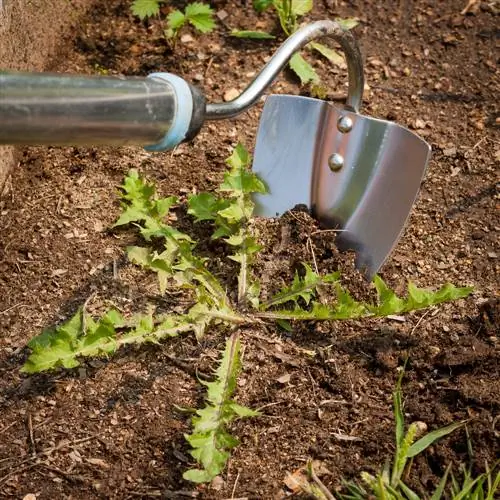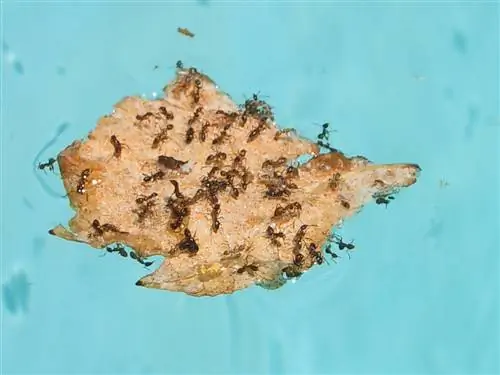- Author admin [email protected].
- Public 2023-12-16 16:46.
- Last modified 2025-06-01 06:02.
Red ants in the lawn and garden are not a source of unadulterated joy, even for nature lovers. Our admiration for ingenious ant colonies reaches its limits when nest mounds become dangerous stumbling blocks. Species protection and a sense of responsibility prohibit resorting to toxic control methods. Instead, you can outsmart small red ants with a simple trick or gently combat them using natural remedies. This guide explains the details in detail and comprehensibly.
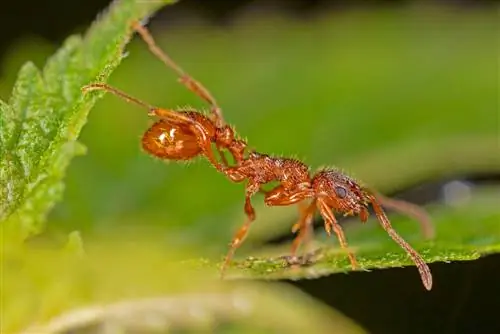
How do I fight red ants without poison?
To combat red ants without poison, you can relocate them by placing flower pots filled with wood shavings over nests or walkways, or scare them away with natural remedies such as nettle liquid, algae lime or lemon juice.
- The best remedies against red ants in the lawn are relocation and repeated application of nettle manure.
- Algae lime, water shower, relocation or aphid control can help against red ants in the garden.
- Red wood ants bite. Small red garden ants sting. Bites and stings are painful, but not dangerous.
Fighting red ants without poison - an overview of gentle remedies
Natural hobby gardeners don't waste any thought on destroying red ants. Apart from a few annoying habits, ants are diligent pest destroyers and make a valuable contribution to ecological balance. If small red ants boldly march into the garden and boldly colonize the lawn, you can drive away the troublemakers using simple means. The following table lists the best options for lawns, garden beds and houses:
| In the grass | In the bed | In the house | |
|---|---|---|---|
| Top-Medium | Flower pot trick | Flower pot trick | Chalk |
| Home remedies | + Nettle Manure | + Wormwood Manure | + essential smells |
| + Algae limestone | + lemon juice | ||
| + Water | + Vaseline | ||
| + Fighting aphids | + Vinegar |
These tools are based on three effective strategies: resettlement, disorientation and food shortages. The flower pot trick works equally effectively in the lawn and garden. Home remedies target the ants' fine sense of smell or create insurmountable travel barriers. By fighting aphids, you deprive red ants of an important source of food. The following sections explain the correct application.
Red ants in the lawn - what to do?
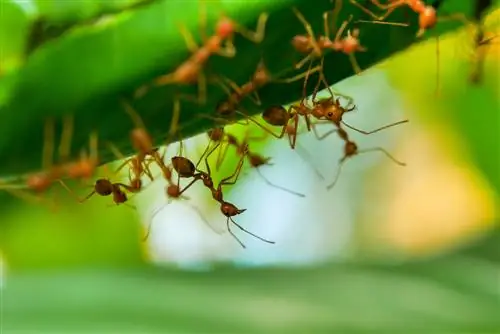
The red garden ant likes to settle in the lawn
If there are small red ants in the lawn, they are usually red garden ants (Myrmica rubra), a species of ant that is widespread in Europe. An average colony has 1,200 workers who look after up to 15 queens and their brood. An unpleasant side effect is that nest mounds grow to considerable dimensions. Apart from the spoiled lawn, walking barefoot or taking a peaceful nap on the grass becomes a painful interlude due to aggressive ant soldiers. Use the following two methods to send the malicious red ants into exile:
Relocating with a flower pot trick

Red ants dedicate their entire lives to the service of their offspring. Building a safe nest is one of the most important tasks and biggest challenges for the busy workers. The lawn is recognized early on as a poor choice of residence because regular mowing causes turmoil. This is where the flowerpot trick comes in. By offering the red ants in the lawn a tempting alternative, you can gently relocate the entire colony. This is how it works:
- Fill flower pots with wood wool
- Turn over pots
- put over nests and walkways
It takes a few days for red ants to appreciate the advantages of the new apartment. Moving activity can be recognized by red ants dragging cream-yellow pupae into the flower pot. Then push a spade under the new nest and carry the colony to a location that does not pose any conflict with humans. The distance to the lawn should be at least 30 meters so that homesick red ants cannot find their way back.
Scaring away with nettle manure
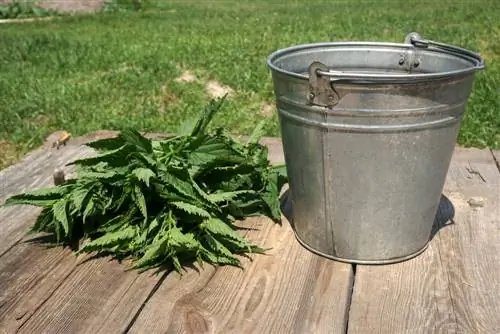
Stinging nettle manure repels ants and is also a great fertilizer
Stinging nettle manure is an effective way to scare away annoying red ants in the lawn. The strong smell masks the scent markings that ants use to orient themselves. As a positive side effect, nitrogen-rich nettle manure serves as an organic fertilizer for a lush green lawn. This is how it works:
- Collect 1 kg of fresh nettle leaves and let them wilt for 8 hours
- fill into a wooden tub and pour 10 liters of collected rainwater over it
- Cover tub with rabbit wire
- Set up in a partially shaded location (as far away from the building and terrace as possible)
- stir daily with wooden stick
The fermentation process is complete after about 14 days. Now you can strain the manure and dilute it with rainwater in a ratio of 1:10. Use a watering can or sprayer to spread the plant manure on the lawn early in the morning or after sunset. Repeated use increases the anti-ant effect.
Excursus
Red ant bite - dangerous or harmless?
Large red forest ants (Formica rufa) have powerful mouthparts that are used for defense in an emergency. Anyone who gets too close to the nimble workers while walking in the forest will be punished with a noticeable bite. Small red ants (Myrmica rubra) in the garden are too weak to bite through the skin of humans or prey. A poisonous stinger on the abdomen compensates for this handicap. In both cases, red ants inject an acid into the wound. Slight red swelling and itching are the harmless consequences for a he althy person. Bite and sting victims with a history of insect venom allergy should consult their family doctor after a confrontation with red ants.
Red ants in the garden - what helps?
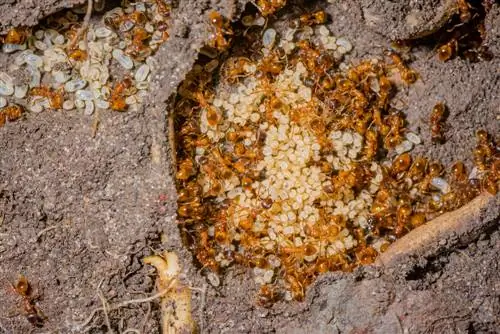
Red ants in the garden should not be poisoned but rather scared away or relocated
With busy streets, disturbed, undermined garden soil and nest mounds, red ants drive hobby gardeners to despair. Anyone who gets too close to the aggressive workers will feel the poisonous sting. Recognizing the important functions of ants in the ecosystem, concerned gardeners prefer gentle, non-toxic means to drive the uninvited guests from the garden. How to scare away little red ants from the garden never to be seen again:
- relocate: place pots filled with wood wool over the walkways or nests (see above for the flower pot trick)
- confuse: Sprinkle algal lime on walkways, nests and surrounding ground, spray wormwood manure
- wear down: Water nests and walkways daily with a watering can without drowning the ants
- Fighting aphids: Destroy aphids on plants with soft soap solution
A combination of all recommended methods promises maximum success. It is no coincidence that red garden ants are one of the most successful ant species in the world. They have to give the ant colony a hard time so that the workers can piggyback on the brood and leave the garden. If a softly padded flower pot beckons, while algae and regular watering get on your nerves, the red ant workers can be persuaded to emigrate. At the latest when there are no more aphids in the garden that provide sweet honeydew, there will be no stopping the red ants.
Tip
Pseudo home remedies such as baking powder, coffee powder, boiling water and the beer-honey trap are criticized. Using these control methods condemns valuable red ants to a painful death.
Little red ants in the house
In search of food sources for their people, courageous ant scouts break into the house. The little red ants have their sights set on openly stored food supplies in order to attack them. You can put a stop to the goings-on with natural remedies. These methods have proven themselves well in practice:
- Walking barriers: draw thick chalk lines or spread Vaseline in strips and renew regularly
- Disorientation: Confuse the sense of smell with essential scents such as eucalyptus, fern, camphor, juniper
- Annoyance: Spray the soil regularly with lemon juice, vinegar or vinegar water
As an alternative to chalk, you can use inexpensive baby powder to create an insurmountable walking barrier. Instead of petroleum jelly, cheap grease acts as a sticky barrier that prevents red ants from entering. Fresh lemon juice quickly loses its effectiveness. By studding lemon slices with cloves and placing them at suspicious entry points, you optimize the effectiveness of the home remedy against an invasion of small, red ants.
Frequently asked questions
What do you do about red ants in the lawn?

Brunning nettle manure causes ants to run away
Two approaches have proven successful in gardening practice for the poison-free control of red ants in the lawn. Resettlement promises the best chance of success. To do this, place an old flower pot over the nest or walkway, which you have previously comfortably padded with wood wool. When long caravans of workers are relocated with pupae in their luggage, use a spade to carry the flowerpot nest to a safe location. The second option is to regularly spray the lawn with nettle manure. Ant workers can no longer find their way to the nest, so the plague in the lawn quickly ends.
Are little red ants dangerous?
Small red ants are red garden ants (Myrmica rubra), also known as red-yellow knot ants. A poisonous stinger on the abdomen is characteristic of this widespread ant species. If the red garden ants feel threatened, they do not hesitate to use the stinger rigorously. This can also penetrate human skin. An acid is injected. Severe pain, red swelling and annoying itching are the result. For a he althy person this is annoying, but not dangerous.
Can red ants in the lawn or garden also be the aggressive red fire ant?
So far, red fire ants (Solenopsis invicta) have caused a lot of headaches, especially for people in the USA. The aggressive ants have been spreading invasively there since they were introduced from Argentina around 100 years ago. What is fatal is that neither poison nor biocides have been able to stop the red fire ant so far. The dreaded ant species has not yet appeared in the wild in Germany. Experts fear that sooner or later they could be introduced into Europe in potting soil or other goods. Until then, red ants in Germany are either the protected red wood ant or the red garden ant.
Tip
Small red ants are not afraid to build their nests under paved surfaces. The result is wobbly paving stones and natural stone slabs with gaps that pose dangerous tripping hazards. It doesn't have to come to that if you use special, polymeric joint sand with an anti-ant effect, for example Dansand, for paving work[/llink] in the garden.


